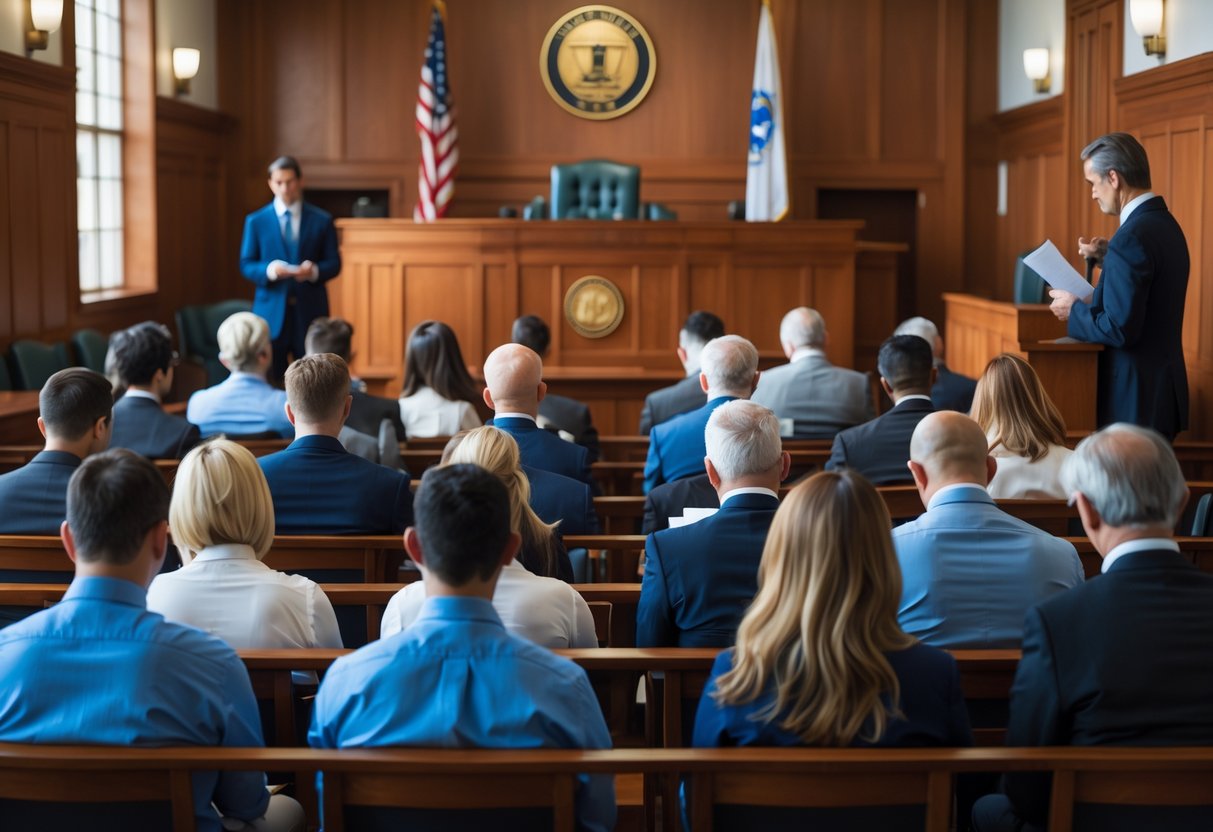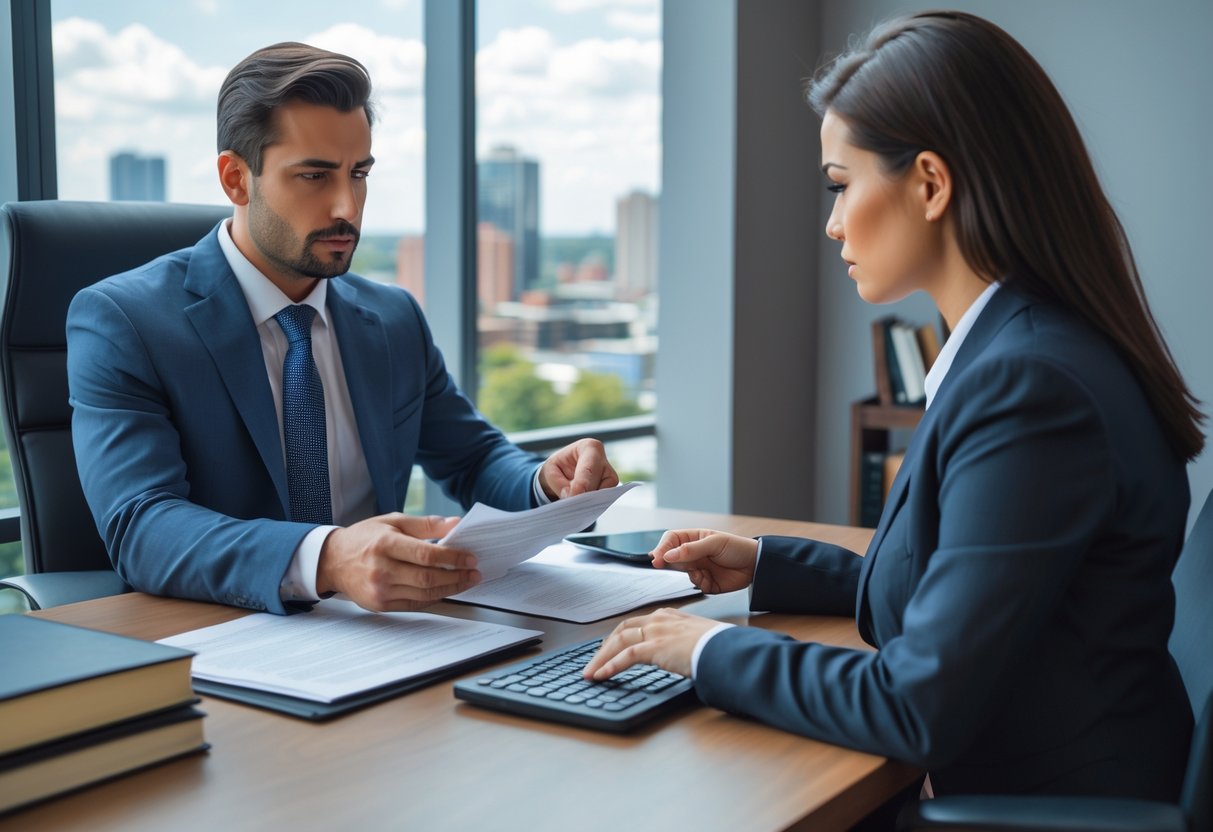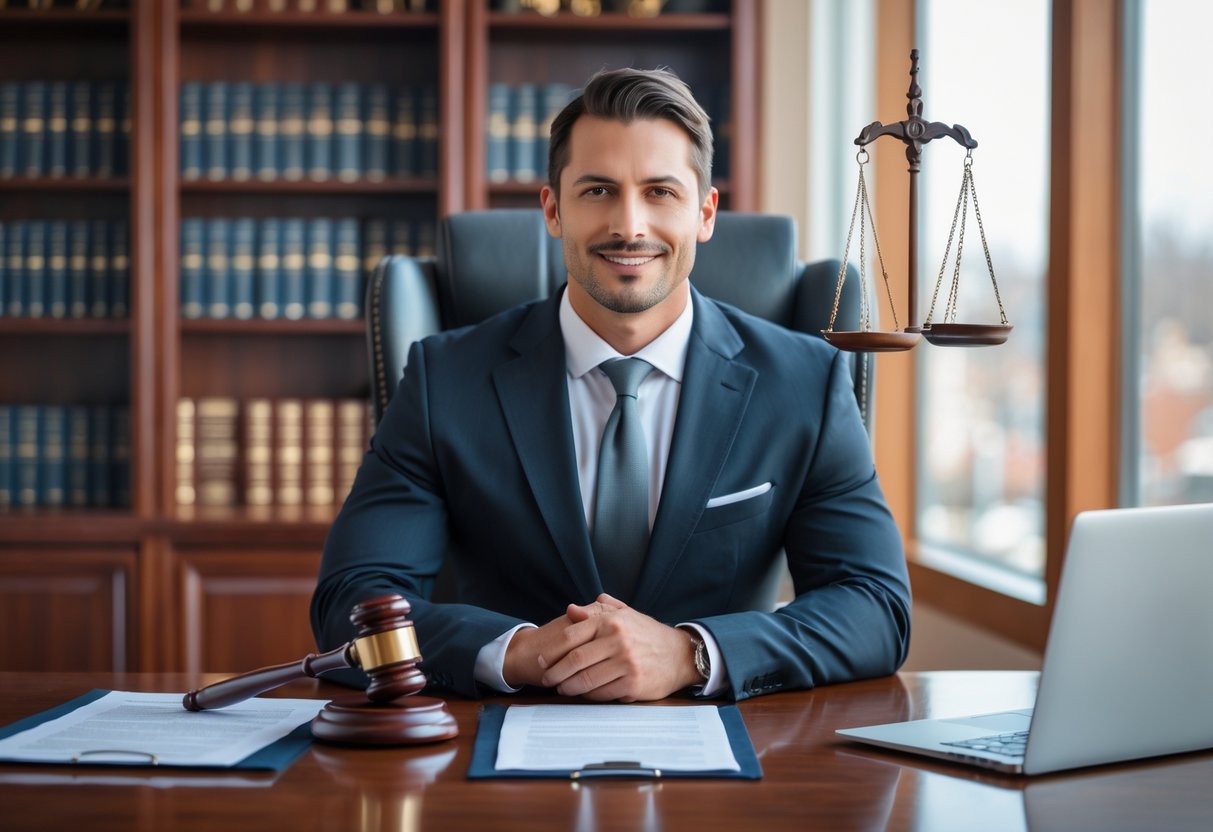Jury selection is a crucial part of every criminal trial and shapes the outcome more than most of us realize. The process of choosing a jury helps ensure the trial is as fair as possible for both the defendant and the community. By carefully selecting jurors, we help protect our rights in the criminal justice system.

We might think jury selection is just a routine step, but it actually sets the tone for the trial. The people who fill those seats will decide someone’s future based on the evidence and the law. Understanding how and why we select jurors gives us a clearer view of how justice is served.
Overview of Jury Selection in Criminal Trials
Jury selection is a careful process used to choose the people who will decide a defendant’s guilt or innocence in criminal trials. It shapes outcomes in the United States criminal justice system by creating a fair and impartial jury.
Importance of Jury Selection
In criminal cases, the importance of jury selection cannot be overstated. The jurors we choose are responsible for listening to evidence, following the law, and making decisions that can greatly affect people’s lives.
A fair jury pool helps ensure both sides in a criminal trial have a chance at justice. Unfair or biased jurors can threaten a defendant’s right to a fair trial. Because of this, both the defense and the prosecution have the right to question potential jurors. By using challenges for cause and peremptory challenges, lawyers can try to remove jurors who may not be impartial. This process helps us avoid wrongful convictions and protect civil rights.
Legal Foundations and the Sixth Amendment
The Sixth Amendment to the United States Constitution lays the foundation for jury selection in criminal trials. It guarantees the right to a “speedy and public trial, by an impartial jury.” This means everyone accused of a crime has the right to have their case heard by a group of their peers.
Our legal system has rules in place to make sure jury selection follows these protections. Laws and court cases guide how potential jurors are selected, questioned, and removed. For example, jurors may not be excluded based on race or gender, as established by Supreme Court decisions. These protections support fairness and aim to prevent discrimination in the justice system.
Role of the Jury in Criminal Trials
The jury plays a key role in criminal trials by acting as a fact-finder. Jurors listen to the evidence, hear witness testimony, and look at exhibits presented in court. They do not decide legal questions, but they do decide if the defendant is guilty or not guilty based on the evidence.
We trust jurors to keep an open mind and make decisions based only on what happens inside the courtroom. Their job is important because their verdict can protect the innocent, hold the guilty accountable, and impact the lives of everyone involved. The system depends on our juries to act fairly and responsibly.
The Jury Selection Process Explained

Jury selection plays a big part in making sure criminal trials are fair and balanced. We need to understand how people are chosen to serve and the steps taken to form a jury from our community.
Jury Pool and Jury Summons
The process starts by gathering a group of potential jurors called the jury pool or venire. We select these names from public records, such as voter registrations and driver’s license lists.
A jury summons is then mailed to people in the pool. This summons requires them to report for jury duty at the courthouse on a specific date. Failing to respond can lead to fines or other legal action.
When summoned, people answer basic questions about their background. Judges and attorneys use this information to make sure the jury pool meets legal and impartiality standards. They check for any potential conflicts, such as personal connections to anyone involved in the case.
If a person has a valid reason, like illness or serious hardship, they may be excused from serving. This keeps the process fair for everyone.
Random Selection and Formation of the Jury Panel
After the jury pool arrives, we use a random selection method to choose a smaller group, known as the jury panel. This is usually done by picking names or numbers so no one gets chosen in a biased way.
Once the panel is set, judges and attorneys ask more detailed questions in a process called voir dire. This helps us determine whether people are fit to serve on that specific trial. Both sides can ask to remove certain people for clear reasons, like personal bias.
We repeat this process until we have the right number of jurors for that trial. The goal is a jury that is as fair and impartial as possible, helping ensure trust in our jury system.
Voir Dire: Questioning Potential Jurors
In the United States criminal justice system, choosing an impartial jury is a key step. During voir dire, judges and attorneys work together to question potential jurors and search for signs of bias.
Purpose of the Voir Dire Examination
During the voir dire examination, we focus on finding jurors who can judge the case fairly. Our goal is to build an impartial jury. This means jurors must listen to evidence and decide the case without letting feelings or other outside issues get in the way.
This step helps protect the defendant’s right to a fair trial. In a typical voir dire, we ask questions about the jurors’ backgrounds, jobs, and beliefs. We may also ask about news coverage they have seen about the case, which helps us see if pre-trial publicity could affect their views.
We don’t want anyone on the jury who can’t be neutral. If someone admits they already believe the defendant is guilty or have a personal connection to the case, they’re likely to be removed.
Identifying Biases and Prejudices
Bias can come in many forms. Sometimes, it’s clear, like when someone admits they know the defendant. Other times, bias is hidden, and it takes careful questions to uncover it. We try to find out if any jurors have strong opinions about the law, the people involved, or the crime itself.
We ask about past experiences that might affect how a person sees the case. This includes their encounters with law enforcement, experiences as a crime victim, or attitudes toward certain groups. Our aim is to check for all types of bias: racial bias, religious bias, or even bias from news stories.
Common questions asked during voir dire include:
- Have you or your family ever been involved in a similar case?
- Do you have strong feelings about the justice system?
- Have you formed any opinions about the defendant based on the media?
These questions help us identify and remove anyone who might not be fully impartial.
Role of Judges and Attorneys in Voir Dire
Both judges and attorneys have important roles during voir dire. The judge usually starts by explaining the process to the jury pool. The judge also asks some basic questions to the group. After that, the attorneys both the defense attorney and the prosecution ask more detailed questions.
Attorneys use their questions to see if someone should be excused for cause, meaning there is a clear reason the person cannot be fair. They can also use a limited number of peremptory challenges to remove jurors without giving a reason. However, peremptory challenges cannot be used for reasons related to race or gender.
The judge oversees the process to make sure it’s fair. Judges can decide if someone’s answer means they should be excused from the jury. This teamwork between judges and lawyers helps us select a panel that is as fair and unbiased as possible.
Challenges and Strikes in Jury Selection
During the jury selection process in criminal trials, legal professionals use specific methods to decide who will serve as jurors. These methods include challenges for cause, peremptory challenges, and careful attention to legal and ethical standards.
Challenges for Cause
In criminal law, we can ask the court to remove a potential juror for a specific legal reason. This is known as a challenge for cause. If it is clear that a juror cannot be fair or impartial, such as having a connection to the case or showing strong bias, we must bring this to the judge’s attention.
The judge has judicial discretion to decide if the challenge is valid. Judges listen to both the lawyers and the potential juror before making a decision. If the challenge is accepted, the juror is dismissed and another person is considered.
Some common grounds for challenges for cause include:
- The juror knows the defendant or the victim.
- The juror has strong opinions about the crime.
- The juror admits they cannot be neutral.
Using these challenges protects the defendant’s right to a fair trial.
Peremptory Challenges
We also have the option to use peremptory challenges during jury selection. With these challenges, we can remove a juror without having to state a reason. However, each side only gets a set number of peremptory challenges, and this number is limited by law.
Peremptory challenges are important because they help us shape the jury when we have a concern that doesn’t meet the standard for a challenge for cause. For example, we may sense subtle bias that is hard to prove.
The process aims to balance the interests of both the defense and the prosecution. However, legal professionals are not allowed to use peremptory challenges to exclude someone based on race, gender, or other protected traits. If there is evidence this is happening, the judge can ask for an explanation and may reject the challenge.
Legal and Ethical Considerations
We must follow clear legal and ethical rules during jury selection. The Constitution protects the right to an impartial jury. Both challenges for cause and peremptory challenges are subject to this guarantee.
Judges oversee the process to ensure fairness and proper use of legal concepts. If a lawyer abuses the challenge system, it can lead to a mistrial or appeals. Striking jurors for illegal reasons, such as race or gender, violates federal law and court rules. Courts may use the Batson challenge procedure to stop unfair exclusions.
Ethical guidelines also require us to act honestly and avoid misleading the court. These standards help protect the rights of both the accused and the community during criminal trials.
Role of Jury Consultants and Legal Strategies
In a criminal case, the jury we select can shape the outcome. By using expert help and smart planning, we can give our legal representation the best chance of a fair trial.
Jury Consultants in High-Profile Cases
Jury consultants are often used in high-profile criminal cases. They help criminal defense attorneys during jury selection by analyzing potential jurors. These experts use surveys and background checks to spot any potential bias.
We often rely on a jury consultant’s knowledge of social science and behavioral cues. They may sit with us in court and watch how jurors react to questions or certain topics.
Key services provided by jury consultants include:
- Creating juror profiles
- Developing voir dire questions
- Making suggestions on strikes and challenges
- Offering insight on how jurors may respond to case facts
In cases that attract media attention, the right consultant can help us manage publicity and select jurors who will listen only to evidence, not rumors.
Legal Strategies During Jury Selection
Legal strategies in jury selection can change based on the type of criminal case and its details. As criminal defense attorneys, our team uses voir dire, a process for questioning jurors to spot any bias or unfair attitudes.
We may use the following strategies:
- Asking direct questions related to the case
- Identifying jurors with life experiences related to the crime
- Making peremptory challenges, allowing us to remove jurors without giving a reason
- Using for-cause challenges for clear conflict or unfairness
Careful questioning helps us build a list of jurors likely to listen to facts. Our legal representation works to create a balanced jury for the best possible trial results.
Ensuring Impartiality and Addressing Juror Bias
Impartiality in the jury is necessary for a fair trial. Problems like pre-trial publicity and personal opinions can affect a juror’s ability to be unbiased in the United States criminal justice system.
Screening for Impartiality
During jury selection, we use a process called voir dire to question possible jurors. This helps us learn about their backgrounds, opinions, and if anything might affect their objectivity. Attorneys for both the prosecution and defense may ask direct questions about news coverage, social media use, and experiences with the law.
If we find that someone has formed an opinion from pre-trial publicity, we may challenge them for cause. There are also peremptory challenges, where lawyers can remove a juror without giving a reason, though this number is limited. Our goal is to choose people who have not made up their minds and who promise to look only at the evidence.
We must make sure to follow legal rules and avoid discrimination while selecting an impartial jury. Regular, documented steps help show that the process is thorough and fair.
Addressing Pre-existing Biases
Juror bias can come from personal beliefs, experiences, or exposure to media about the case. We ask questions to uncover these biases and to see if a person can follow the court’s instructions instead of their own views.
If someone admits they cannot be fair, we excuse them. Sometimes, bias shows up in more subtle ways, like strong beliefs about law enforcement or certain crimes. We pay attention to non-verbal cues and answers that suggest hidden prejudice.
Judges also warn jurors not to talk about the case with outsiders or seek out news. This limits outside influence and helps protect impartiality during the trial. Keeping jurors focused on just the facts gives both sides the best chance for a fair outcome.
Jury Deliberation and Reaching a Verdict
Jury deliberation is when we discuss the facts of the case in private to decide if the accused is guilty or not. The process relies on how well we understand the evidence and the legal instructions we were given by the judge.
Evaluating Evidence and Legal Instructions
During deliberation, we review the facts of the case, such as witness statements and physical evidence. It’s our job to look at each piece of evidence and decide how much we believe it. Sometimes the criminal defense may point out weaknesses or problems in the evidence, and we have to pay close attention to these details.
The judge gives us legal instructions to guide our decisions. These instructions explain what the law means and what each charge requires. We cannot use our own ideas about the law. Instead, we must follow the directions the judge gives us step by step.
Checklist for evaluating evidence:
- Review all exhibits (photos, documents)
- Discuss witness credibility
- Consider if evidence supports the facts
- Check if instructions match the evidence
We must stay neutral and base our decisions only on what was shown in court.
Jury Deliberations and Unanimous Decision
When we start jury deliberations, we talk openly about what the facts mean. We each share our thoughts and listen to each other. In criminal trials, reaching a verdict usually requires a unanimous decision, which means every juror must agree.
We use organized discussion and sometimes take votes to see if we all agree. If anyone disagrees, we keep talking until we all come to the same conclusion, whether it is guilt or innocence.
| Deliberation Steps | Action |
|---|---|
| Discuss evidence | Review all facts of the case |
| Clarify the law | Use the judge’s instructions |
| Take initial vote | See if consensus may exist |
| Continue discussion | Work through disagreements |
| Final vote | Reach a unanimous verdict |
Our verdict must be based only on the evidence and law explained in court, without outside influence. If we cannot agree, sometimes a hung jury is declared, and the trial may end without a decision.
Special Considerations in Criminal Trials
In criminal trials, unique issues can affect the path and outcome of a case. We must pay close attention to how juror selection works when alternates or special verdicts may be needed.
Alternate Jurors and Hung Juries
Alternate jurors are backup jurors who listen to the entire criminal case with the main jury. They step in if a regular juror cannot continue because of illness or another serious reason. This keeps the trial moving forward instead of starting over.
A hung jury occurs if jurors cannot agree on a verdict after careful discussion. In criminal trials, this means the decision must usually be unanimous. If one or more jurors disagree and will not change their vote, the judge may declare a mistrial.
A mistrial does not mean the defendant is found guilty or not guilty. Instead, prosecutors may decide to try the case again with a new jury. This process is costly and difficult for everyone involved, especially the defendant and the legal system.
Sentencing and Bench Trials
Sentencing in a criminal case happens after a guilty verdict. Our laws often give judges specific rules they must follow. Sometimes, the jury gives a recommendation, but the judge makes the final decision. The judge considers things like the crime’s seriousness and any past criminal record.
A bench trial is another option. In a bench trial, the judge serves as both fact-finder and law interpreter, taking the place of a jury. Defendants can choose a bench trial instead of a jury trial. This might happen if the issues are mostly legal or if publicity could affect the jury’s decision.
We need to understand these differences because the choice between a jury and a bench trial or the way sentencing is handled can lead to very different outcomes in a criminal trial. Each option has its advantages and challenges.
Impact of Jury Selection on Appeals and Mistrials
How a jury is chosen can strongly influence both the fairness of a trial and what happens next if there are mistakes. If there are problems in the jury selection process, it might lead to an appeal or even a mistrial, changing the path of a criminal justice case.
Grounds for Appeal
In criminal trials, one reason to file an appeal is error during the jury selection process. If a jury is selected in a way that breaks the law or is unfair, we can challenge the outcome in a higher court.
Some common grounds for appeal include:
- Improper removal or exclusion of jurors
- Discrimination against potential jurors based on race, gender, or other protected factors
- Failing to remove biased jurors from the panel
If the appeals court finds that mistakes in jury selection affected the fairness of the trial, it may order a new trial or overturn the conviction. Not all errors result in a new trial, but serious violations can have large effects.
Effect of Improper Jury Selection
Improper jury selection may result in a mistrial. This happens if the process is so flawed that we can’t be sure of a fair verdict.
Possible effects include:
- Wasting important resources (time, money, and effort)
- Emotional stress for everyone involved
- Needing to start the jury trial over with a new group
- Damage to public trust in the criminal justice system
A mistrial does not mean the defendant goes free. Instead, the case may be tried again with a new jury. This delays resolution and can change outcomes. Proper jury selection is vital for a valid and efficient trial.




